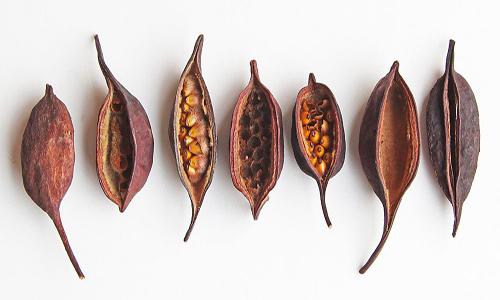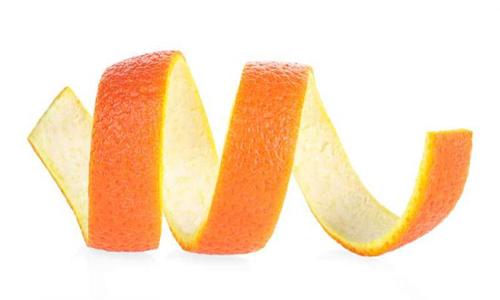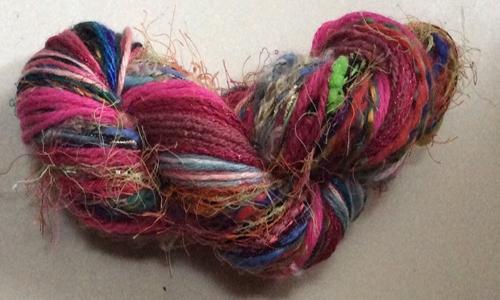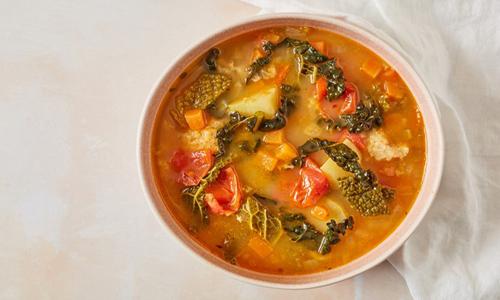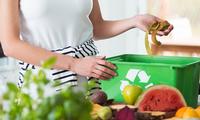by Nourishing Literacy staff members Shayna M. and Carolyn
After reading a New Yorker article a few weeks ago, our curiosity and interest grew in how to use kitchen scraps in resourceful ways. Tamar Adler, the highlighted chef and cookbook author in the article, is passionate about creating wholesome, satisfying dishes with foods that are sometimes overlooked.
Inspired by the recent Rare Books Department exhibit, Our Five Senses, we explore gardening, creating, and cooking from scraps through this lens. In the fall and winter of this school year, many Nourishing Literacy students were able to view this exhibit and make the natural connection to food and cooking!
Touch
Spring is the season for gardening. The ground softens and the earth yields under our fingers. We dig in the dirt and plant seeds, tug weeds free, jump in puddles, and enjoy the blessings of a rain-filled April. Philadelphia is an oasis of urban gardens but you don’t need much outdoor space to take part in these rituals of hope and renewal while reusing scraps in the process.
Check out this recent Philadelphia Inquirer article for indoor gardening projects such as sprouting pantry items like lentils and black-eyed peas and planting spice seeds, as well as tips on growing veggies from scraps.
You can start seeds on a windowsill with an eggshell or a used tea bag, in three easy steps:
- Open your tea bag or put a little soil in ½ eggshell
- Plant a seed inside
- Transfer to the ground or to a larger pot when the seedling begins to grow.
Both tea leaves and eggshells will enrich the soil with nutrients. Coffee grounds are another great food scrap fertilizer. Save them from the trash and sprinkle over edible plants that will benefit from nitrogen, potassium, and phosphorus. For more ideas, check out Deep-Rooted Wisdom: Skills and Stories from Generations of Gardeners and Don't Throw It, Grow It!: 68 Windowsill Plants from Kitchen Scraps, available as ebooks with your library card.
You can also harvest seeds from plants. As flowers die, their seeds mature and the seed pods holding them (see image) are ready for harvesting. Cut these carefully, dry fully, place in a labeled envelope or sealed jar, and store in a cool, dry spot. Plant these next spring, and save yourself the time and expense of buying packets. Check out the Free Library’s ebook resource, The Weekend Homesteader: A Twelve-Month Guide to Self-Sufficiency, for more.
Philly is home to many edible weeds. Take a walk with an eye to the ground cover, grab a handful, and try any of the following: white clover, dandelion, purslane, violet, Lamb’s quarters, wild onions, chicory, or plantain. The Philadelphia Orchard Project has a helpful Weed Identification Guide, including information about which weeds "to tolerate" (or to keep) because of their benefits.
Smell
Rub a fresh herb like basil or cilantro between your fingers and take a deep breath in, letting the scent tickle your nose. Along with the peels from citrus fruits—think lemon, lime, orange, and grapefruit—herbs engage our sense of smell. They make foods and beverages more fragrant, and the combination of smell and taste heightens the pleasure of eating and drinking. We can also get more mileage out of herbs and peels if we rethink their scraps.
Did you know that you can grow new herbs from 'cuttings,' or small pieces of store-bought ones? Mint, rosemary, sage, thyme, parsley, and more are a cinch to grow from a small cutting. All you need is a pair of scissors, a glass or other small container to hold the cuttings in water, and a sunny spot.
Next time you’re about to toss a citrus peel into the garbage or compost bin, think again! Citrus zest makes baking even more fun. Grapefruit donuts, chocolate orange cake, key lime pie, and lemon tart are just a few of the specialty items that incorporate citrus zest, but you can also add zest or peel to everyday treats like pancakes and cookies. A slice of peel rubbed along the side of a glass or added to a beverage will make any drink more fun. Like sweet potato fries? Try dipping them in yogurt with lime zest and juice, and a little salt, garlic, and ginger. Remember to grate or zest before juicing, as it’s hard to do the other way around.
Check out the ebooks Don't Throw It, Grow It!, for more on growing herbs from scraps, and The CSA Cookbook, for a great recipe that combines basil blossoms (the flowers that are often removed from the plant and considered trash or compost) with orange peel to make a vinegar salad dressing.
Hearing
Want to hear more inspiring stories of rethinking food waste? Join Nourishing Literacy for a watch party! We’ll watch Make Food, Not Waste together soon. We’ll listen together and learn about food banks, composting, and a unique system called Bokashi, then we’ll share and hear reactions from one another.
As you watch and listen, consider these questions:
- Were you surprised to learn that nearly half our food ends up in the trash? How does that make you feel?
- What do you do with your food waste (the odds and ends that you don’t eat, like apple cores or banana peels)?
- What can you do to help transform your food waste into a resource?
- What further questions or ideas do you have about transforming food waste into a resource?
Make Food, Not Waste is a 25-minute PBS documentary, available through Kanopy, one of the Free Library’s video streaming platforms. Kanopy allows Free Library cardholders to stream four free films per month from a vast collection of different genres for all ages.
A plan for Nourishing Literacy’s first watch party is in the works. Stay tuned to our Facebook and Instagram pages for more info!
Sight
Keep an extra eye on what you can reuse instead of toss when creating arts and crafts. What at first might seem like trash, can become even more beautiful and interesting when your second glance gives it a second chance. For an example of transforming food scraps into art, check out this recent post by our friend Caity, Supervisor of the Culinary Literacy Center, on the CLC Instagram page, about using scraps to dye Easter eggs!
Additionally, our Free Library digital catalog has a variety of resources on using items found in nature to create dye for fabric and fiber. Books like A Weaver’s Garden: Growing Plants For Natural Dyes and Fibers and Natural Dyes and Homedying are a great fit for readers with a serious interest in the art of creating textiles and dying. They also have tons of useful information for anyone interested in doing low-stakes, informal experiments.
A Weaver’s Garden also includes another great use for tea bags. Did you know that chamomile can be used to create gold and greenish-gold dyes? Perhaps you’re curious to see what other colors might come from different varieties of tea or edible flowers, like hibiscus or jamaica (red!). Experiment with the tea bags in your pantry—boil them, then dip and brush onto scraps of paper and see what happens.
Maybe you want to knit from scraps? Try tying together leftover bits of yarn to create a colorful and resourceful skein, or ball of yarn, to practice from! For tips and tutorials to get started working with yarn for our younger friends, check out Knit, Hook, and Spin: A Kid’s Activity Guide to Fiber Arts and Crafts online with your library card.
Taste
Now that some of us have a little extra time on our hands, bread baking (from scratch) is having a moment. As a result, baker’s yeast can be hard to find at the store these days. This article from the New York Times gives insight into cultivating yeast from flour and water. Do It Yourself Yeast! The New York Times is available online with the use of your library card. If inspired by the idea of growing your own yeast, you might want to check out this sourdough starter recipe.
Speaking of bread and cooking from scraps, below is a recipe adapted from Tamar Adler’s take on Bread Soup, or Ribollita. Ribollita is a classic Italian soup, noted for its resourceful use of leftover bread. Another wonderful version can be found in Danny Meyer’s The Union Square Cafe Cookbook, available as an ebook for digital checkout with your library card. Read Meyer’s method for incorporating dried beans if you don’t have cans available.
Ingredients
- 2 Tablespoons oil
- 2 cups diced hearty and aromatic vegetables (a combination of vegetables if possible), such as onion, celery, and carrots
- 2 cloves garlic, minced (optional)
- 2 Tablespoons dried herbs such as oregano, basil, or Italian seasoning (optional)
- ½ teaspoon hot chile flakes or chile powder (optional)
- 1 (14- to 28-ounce) can tomatoes, chopped, with juice
- 1½ to 3 cups dark greens, frozen greens, or drained and rinsed canned greens, chopped
- 1 to 2 cups of cooked beans, or 1 15-ounce can
- 2¼ cups broth, water, or a combination
- 2 cups stale bread, torn or chopped into ½-inch pieces
- Salt and pepper
Directions
- Heat the oil in a large pot over a medium temperature. Add the diced aromatic vegetables, garlic, and a pinch of salt. Stir continuously.
- Add the dried herbs, chile flakes, tomatoes, greens, beans, broth and/or water, and a few pinches of salt. Cover the pot, turn the heat to low, and cook for 5 to 7 minutes.
- Add the bread, turn the heat as low as possible, keep covered, and cook for ½ hour.
- Check occasionally while cooking and add a little extra broth or water, if needed.
- Taste for seasoning, and add salt and pepper as desired. If shredded cheese such as parmesan is available, this can be sprinkled on top of each bowl of soup.
We hope these ideas and resources will inspire you to rethink waste and to give your scraps a new life. Tapping into our senses can open new pathways to renewed engagement with the world around us.
To learn more about the Culinary Literacy Center, please visit our website or connect with us on social media through Instagram and Facebook.
Have a question for Free Library staff? Please submit it to our Ask a Librarian page and receive a response within two business days.

